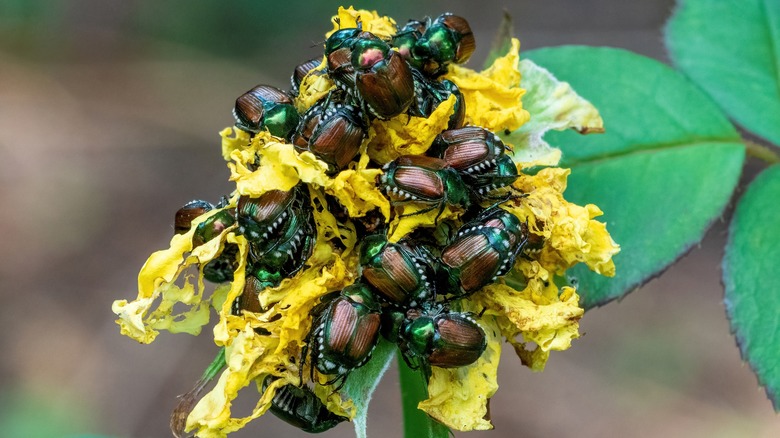If you maintain a garden, one of the biggest challenges you face is keeping your precious plants safe from destructive pests. This includes large animals like squirrels and moles, as well as the tiny insects that are a tad harder to track down and get rid of. Enter Japanese beetles. Not only are they difficult pests to banish from your garden, but they are also an invasive species, meaning they can adapt to different living conditions and terrains. These pesky bugs enter your garden for the same reasons as any other animal does — it’s a favorable environment with enough food. But one thing you probably didn’t know is that a well-watered lawn attracts Japanese beetles to your yard.
You might be stunned to learn that a yard maintenance chore as vital and prolific as irrigation could be the reason why your garden is flooded with hundreds of shiny green and brown insects. There is actually a perfectly reasonable explanation for this, and it all boils down to reproduction. The Japanese beetle’s reproductive process necessitates a wet lawn, as their white eggs need to absorb water to swell in size before they hatch into larvae. This is why a lawn that is constantly wet is a haven for these critters. In order to stop these rapacious bugs from tearing down all your hard work, refrain from watering your lawn for a short period in late summer. This is the easiest approach to getting rid of the Japanese beetles in your garden.
Pay attention to your plants to determine if you have an infestation

Before you let your grass go dormant, you have to be sure that you actually have a Japanese beetle infestation. If you’re still skeptical, check the condition of the fruit, flowers, and leaves in your garden. Japanese beetles are destroyers of over 300 species of plants, some of which you no doubt house in your garden. While their feeding rampage usually just impacts the aesthetics of your garden, they can still cause structural damage to younger plants, which leads to stunted growth and injury. Japanese beetles eat through leaves, making them look veiny and brown. Eventually, these leaves fall off. The critters also eat through flowers, giving them similar holes.
After the eggs hatch, the beetle larvae eat through the roots of your grass, hindering their progress and making dead patches spring up all around the lawn. Since you can’t possibly go around a large garden picking off every Japanese beetle or grub that you see crawling on the dirt, the best route to take when it comes to prevention is making sure their offspring don’t get the chance to survive.
Let your grass go dormant in mid-July to mid-August
Japanese beetle females typically lay their eggs in the soil sometime from late summer to early fall, around mid-July to mid-August. Since the eggs need water to survive, you can prevent their growth by not watering your lawn at all during this period and letting the grass go dormant. Freshly laid Japanese beetle eggs are around 0.06 inches in diameter and get buried about 3 inches below the soil, so they aren’t the easiest things to locate if you go looking for them. The eggs typically take eight to nine days to hatch. So while you likely won’t need to parch your lawn for too long, you have to resist adding moisture to the ground until you’re sure the hatching period has elapsed and then some. Better safe than sorry.
The health of your lawn during the no-irrigation phase depends heavily on the type of turf you have. With warm-season turf grass, you can get away with not watering during the late summer because it typically grows during the warmer months. This grass also has deeper roots and can go without frequent watering for some time. Cool-season grasses, however, grow during the colder months and have shallow roots that need frequent watering. If you have cool-season grasses and a Japanese beetle problem, get a second opinion from a lawn specialist to point you in the right direction so you don’t drought your grass the wrong way.